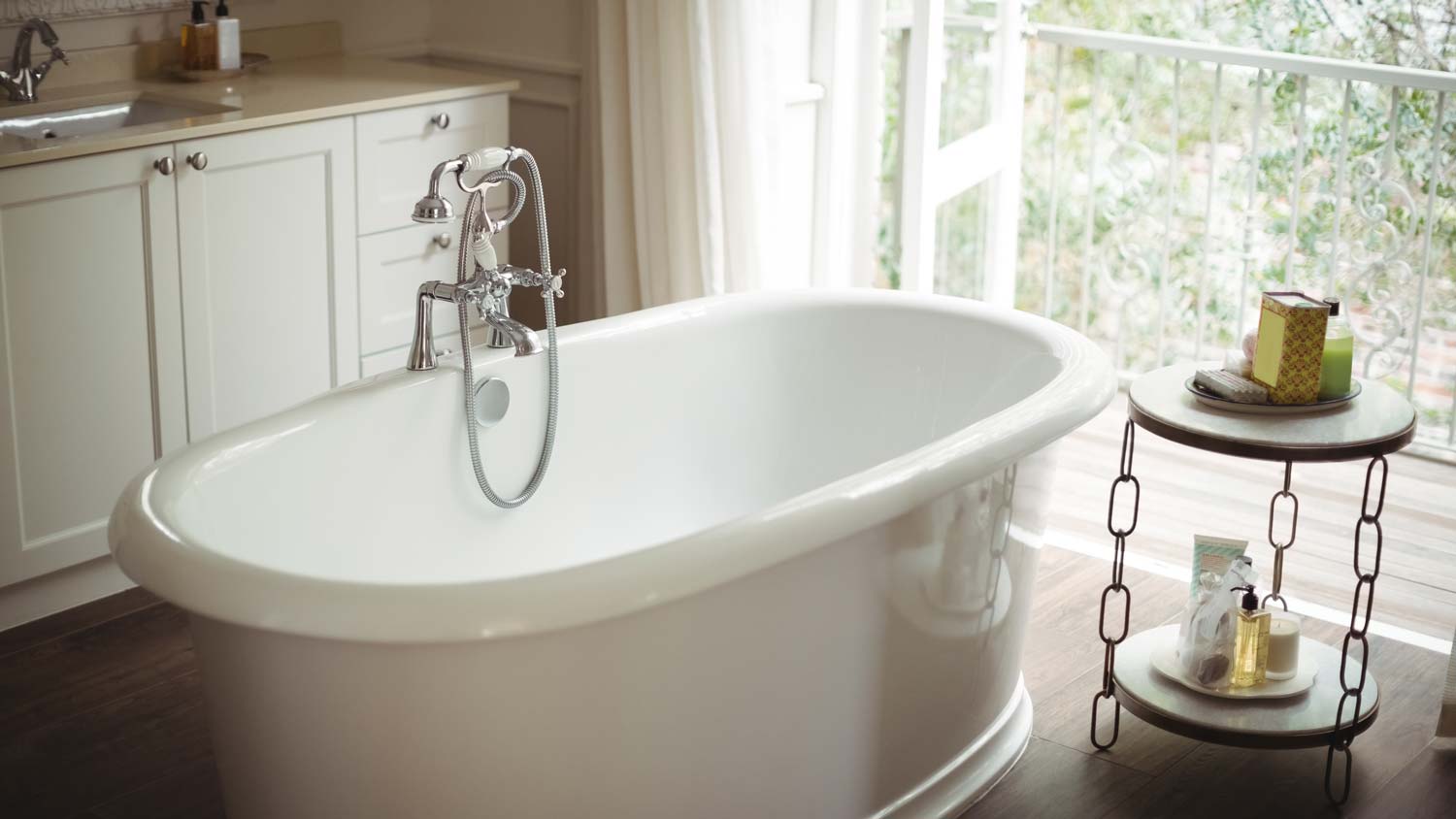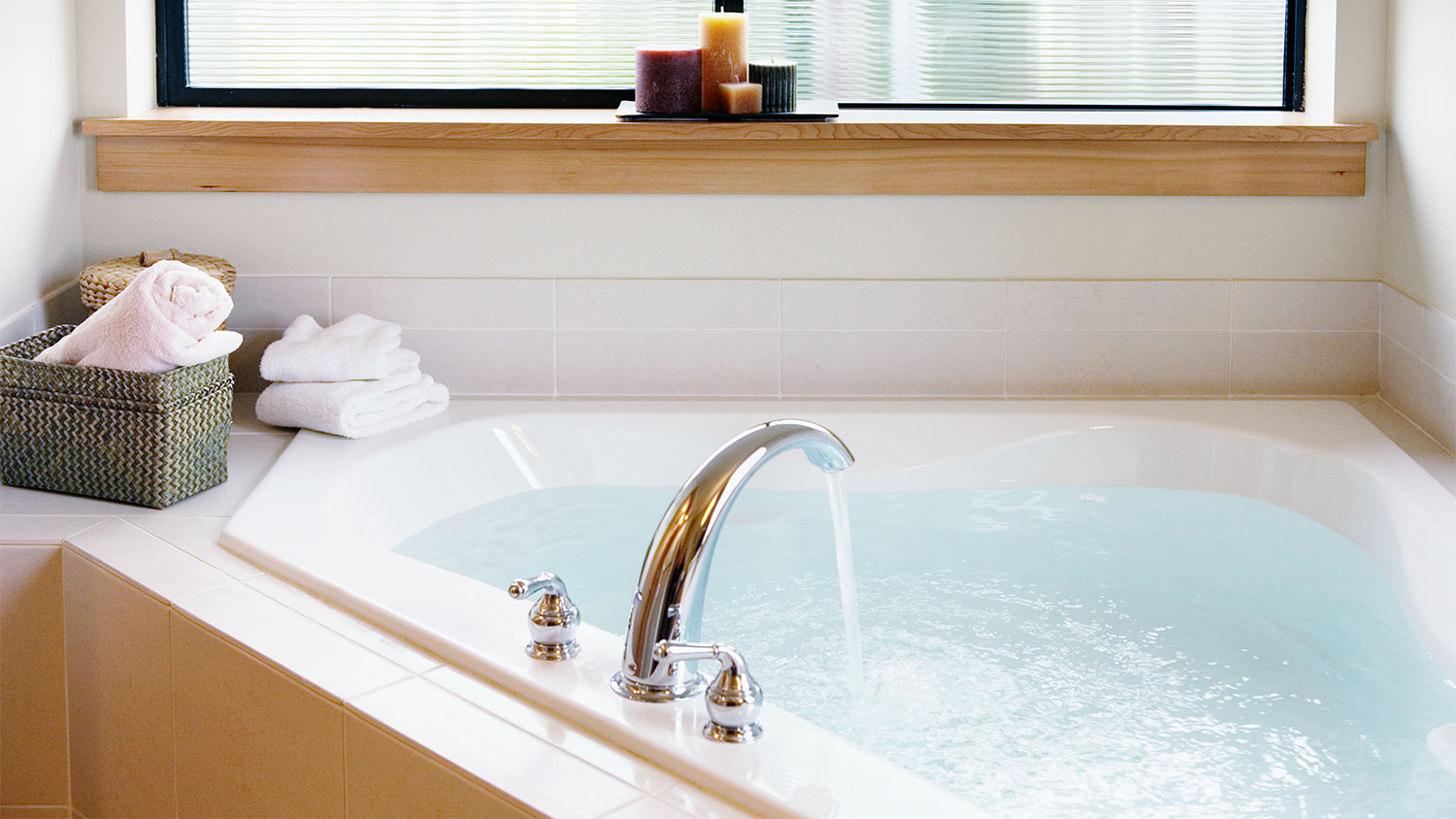
The cost to add a bedroom and bathroom can pay off with an increase in your home’s value and more space for you and your family. Costs vary by project scope.
Walk-in bathtub installation costs average $8,000, with most homeowners paying between $4,000 and $15,000. Your final price depends on tub type, size, features, and labor.


Walk-in bathtub installation cost depends on the type of tub, added features, and installation complexity.
Labor, plumbing, and electrical work can significantly influence your total price, especially if upgrades are required.
Upgrading to a walk-in tub can improve home safety and accessibility, potentially increasing your home’s value and offering an ROI of up to 60%.
Choosing the right features can offer long-term comfort and peace of mind for aging in place or those with mobility needs.
Hiring local professionals costs $75 to $200 per hour and ensures your installation meets all building codes and accessibility standards.
This article was created using automation technology and thoroughly fact-checked and edited by an Angi Editor in accordance with our AI policy.
Walk-in bathtub installation averages $8,000, with most homeowners spending between $4,000 and $15,000 for a complete project. Prices vary based on tub size, features, and labor rates. While there’s no per-square-foot cost, expect higher prices for larger or more customized tubs.
Installing a walk-in tub can enhance safety, comfort, and accessibility at home. This guide explains all the factors that affect walk-in bathtub installation cost so you can plan and budget with confidence.
The size of your walk-in tub is one of the most important factors in determining installation cost. Tubs come in a range of lengths, widths, and depths, and these dimensions directly influence both the purchase price and the complexity of installation.
A standard walk-in tub will fit in the space of a traditional bathtub.
Oversized or bariatric models may require additional bathroom modifications, such as moving walls or reinforcing floors.
Compact tubs are less expensive to install.
Larger models raise both material and labor costs.
The need for extra space or structural adjustments will also add to your overall walk-in bathtub installation cost.
| Tub Type | Dimensions | Average Installation Cost |
|---|---|---|
| Compact | 26–28 in. W x 35–40 in. L | $4,000–$6,500 |
| Standard | 30–32 in. W x 52–60 in. L | $6,000–$10,000 |
| Bariatric or oversized | 32–36 in. W x 60–72 in. L | $10,000–$15,000 |
| Wheelchair-accessible | 32–36 in. W x 60+ in. L | $10,000–$16,000 |
The type of walk-in tub you select has a significant impact on both the upfront cost and the features included. There are several main types to consider, each with its own pros, cons, and pricing considerations:
Soaker tubs are the most basic and affordable, designed for safe bathing without extra features.
Hydrotherapy tubs use water jets for massage.
Air bath tubs rely on air jets for a gentler experience.
Bariatric models are reinforced for higher weight capacity, and wheelchair-accessible tubs feature wider doors and lower thresholds.
Combination tubs offer multiple features but come at a premium.
Custom tubs are designed for unique spaces or needs, increasing both material and labor costs compared to prefabricated options.
| Tub Type | Average Installation Cost |
|---|---|
| Soaker | $4,000–$7,000 |
| Hydrotherapy | Hydrotherapy $6,500–$12,000 |
| Air Bath | $7,000–$13,000 |
| Bariatric | $10,000–$15,000 |
| Wheelchair-accessible | $10,000–$16,000 |
| Combination | $12,000–$17,000 |
| Custom | $12,000–$20,000+ |
Walk-in bathtub installation cost changes depending on where you live. Regional labor rates, the cost of living, and local code requirements all play a part. Urban areas often see higher installation costs due to increased demand and labor expenses, while rural locations may have lower rates but additional travel fees.
Within your home, installing a walk-in tub in a master bath is often less complicated than in a guest or upstairs bathroom. Upstairs installations may require floor reinforcement or special plumbing access, which increases labor and material costs. Tight spaces or bathrooms with limited accessibility can also add to the final price.
Several factors influence the total walk-in bathtub installation cost, from labor and permits to added features and site complexity.
Professional installation involves plumbers, electricians, and sometimes general contractors. Plumbers often charge $75 to $200 per hour, while electricians may bill $70 to $150 per hour.
Labor costs include removing the old tub, prepping the site, installing the new tub, and making necessary plumbing or electrical changes. Urban areas tend to have higher hourly rates, and complex installs can extend timelines, increasing labor fees.
Many municipalities require permits for walk-in bathtub installation, especially if plumbing or electrical work is involved. Permit fees range from $100 to $500, depending on your location. Inspection fees may add $50 to $200. Always check local requirements before starting to avoid fines or delays.
Upgrades such as hydrotherapy jets, air jets, heated seats, chromotherapy (color therapy), quick-drain systems, grab bars, and ADA-compliant features will all raise your walk-in bathtub installation cost. Luxury finishes, custom tile surrounds, and warranty upgrades also add to the total. ADA-compliant or accessible features can increase costs by 10% to 25%.
Several additional factors can affect your walk-in bathtub installation costs, including:
Retrofitting or relocating plumbing and electrical lines increases complexity and price.
Installing in tight spaces or upper floors may require more labor and structural work.
Site prep, demolition, and disposal of the old tub can add $300 to $1,000.
Design or consultation fees for custom installations range from $200 to $1,000.
Required inspections and structural modifications, like floor reinforcement, will further increase costs.
Beyond installation, several ongoing and one-time expenses can affect your overall budget.
Most walk-in tubs come with manufacturer warranties that last five to ten years, covering defects and some repairs. Extended warranties cost $300 to $1,000 and may cover more components or a longer period. Comprehensive coverage can save money on future repairs.
Walk-in tubs use more water than standard bathtubs, raising your monthly water bill. Features like jets, heaters, and pumps also increase energy use. Expect to spend $10 to $30 per month on added utility costs, depending on usage.
Routine cleaning and checking seals or jets are essential. Replacement parts like door seals or jets cost $50 to $300 each. Professional maintenance services are available for $100 to $300 per visit. Most tubs last 10 to 15 years with proper care.
Sales tax on the tub and installation ranges from 5% to 10%, depending on your state and local rates. Taxes can add several hundred dollars to your total walk-in bathtub installation cost.
Walk-in bathtub installation can sometimes reduce homeowners insurance premiums by improving safety and accessibility. Some insurers offer discounts, but requirements vary. Contractors must have liability insurance to protect you during installation.
Deciding whether to install a walk-in tub yourself or hire a pro comes down to cost, skill, and risk.
DIY installation costs $3,000 to $7,000 for materials, tools, and permits. You save on labor but risk mistakes that can cause leaks, water damage, or failed inspections.
You’ll need plumbing and electrical know-how, specialized tools, and the physical ability to move and secure a heavy tub. The project can take several days, and improper installation may void warranties or violate building codes.
Hiring a licensed walk-in tub installer near you ensures your tub is installed safely and up to code. Pros handle site prep, plumbing, electrical, and cleanup. Professional installation costs $8,000 to $15,000, but includes warranty protection and insurance coverage. DIY projects may save money upfront, but professional work offers peace of mind and long-term reliability.
When your walk-in tub has issues, you’ll need to decide whether to repair or replace it. Minor problems, like small leaks or hardware malfunctions, can often be repaired for $150 to $800. If your tub is old, out of warranty, or has major structural damage, replacement is the safer and more cost-effective choice.
Repairs are best for newer tubs with minor issues. If repair costs approach half the price of a new tub, investing in bathtub replacement makes more sense for long-term safety and reliability. New tubs also come with updated features and warranties, adding value and peace of mind.
Walk-in bathtub installation can increase your home’s value, especially for buyers seeking safety and accessibility. The standard return on investment is 50% to 60%, depending on your location and the quality of the installation. Walk-in tubs are particularly appealing in areas with aging populations or for families planning to age in place.
Features like water efficiency and universal design add broad appeal, while luxury finishes can enhance resale value. However, in markets where accessibility is less in demand, the ROI may be lower than for other bathroom upgrades.
Here are some helpful tips to keep your walk-in bathtub installation costs within budget:
Get multiple quotes from licensed installers to compare prices and services.
Choose standard models instead of custom or luxury tubs to keep costs lower.
Schedule installation during off-peak seasons when contractors may offer discounts.
Reuse existing plumbing and electrical lines if possible to avoid extra work.
Opt for only essential features and skip expensive add-ons.
Handle demolition or old tub removal yourself if you can do so safely.
Check for rebates or tax credits for accessibility improvements in your area.
Negotiate warranty terms and installation packages for better value.
Home is the most important place on earth, which is why Angi has helped more than 150 million homeowners transform their houses into homes they adore. To help homeowners with their next project, Angi provides readers with the most accurate cost data and upholds strict editorial standards. We extensively research project costs to develop the pricing data you see, so you can make the best decisions for you and your home. We rely on reputable sources, including the U.S. Bureau of Labor Statistics, academic journals, market studies, and interviews with industry experts—all to ensure our prices reflect real-world projects.
Want to help us improve our cost data? Send us a recent project quote to [email protected]. Quotes and personal information will not be shared publicly.
From average costs to expert advice, get all the answers you need to get your job done.

The cost to add a bedroom and bathroom can pay off with an increase in your home’s value and more space for you and your family. Costs vary by project scope.

Remodeling your bathroom can add significant value to your home. Your bathroom remodel cost in Atlanta, GA will depend on size, fixtures, materials, labor, and other factors.

Small kitchen remodels cost $12,750 on average, depending on the materials, size, labor, and more. Read this to calculate your kitchen remodel costs.

An updated bathtub can give a bathroom a whole new look. Find out how much it costs to replace a bathtub in Dallas, TX, including prices by type and labor costs.

An updated bathtub can give a bathroom a whole new look. Find out how much it costs to replace a bathtub in Charlotte, NC, including prices by type and labor costs.

Undermounted sinks are elegant upgrades to any kitchen and can add to your home’s resale value. But are they the best option? Here we’ll learn the pros and cons of having an undermount sink.